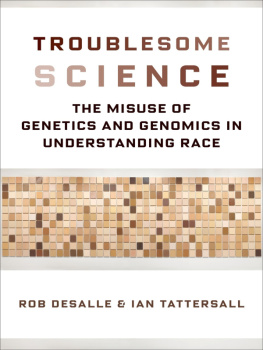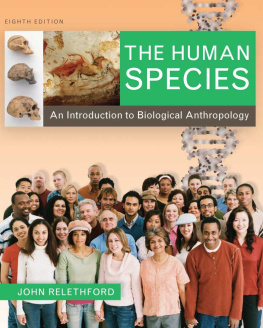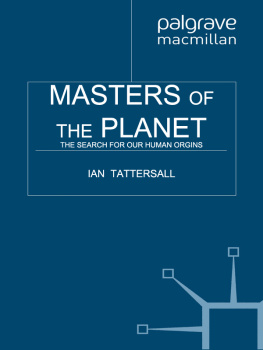Table of Contents
TROUBLESOME SCIENCE
RACE, INEQUALITY, AND HEALTH
RACE, INEQUALITY, AND HEALTH
Edited by Samuel Kelton Roberts Jr. and Michael Yudell
The Race, Inequality, and Health series explores how race has become a basis for discrimination and inequality, as well as a foundation for reactionary or affirmative group politics. The goal of this series is to offer an intellectual space for leading scholars, combining work in history, the social sciences, the biological sciences, and public health that will deepen our understanding of how ideological and scientific claims about race and race difference have impacted health and society both historically and in the present day.
Michael Yudell, Race Unmasked: Biology and Race in the Twentieth Century
TROUBLESOME SCIENCE
The Misuse of Genetics and Genomics in understanding race
ROB DESALLE AND IAN TATTERSALL
COLUMBIA UNIVERSITY PRESS
New York
Columbia University Press
Publishers Since 1893
New York Chichester, West Sussex
cup.columbia.edu
Copyright 2018 Rob DeSalle and Ian Tattersall
All rights reserved
E-ISBN 978-0-231-54630-0
Library of Congress Cataloging-in-Publication Data
Names: DeSalle, Rob, author. | Tattersall, Ian, author.
Title: Troublesome science : the misuse of genetics and genomics in understanding race / Rob DeSalle and Ian Tattersall.
Description: New York : Columbia University Press, [2018] | Includes bibliographical references and index.
Identifiers: LCCN 2017052052 | ISBN 9780231185721 (cloth : alk. paper) | ISBN 9780231546300 (e-book)
Subjects: | MESH: Genetics, Population | Continental Population Groups | Genomics | Biological Evolution
Classification: LCC QH455 | NLM QU 450 | DDC 576.5/8dc23
LC record available at https://lccn.loc.gov/2017052052
A Columbia University Press E-book.
CUP would be pleased to hear about your reading experience with this e-book at .
Cover image: Byron Kim, Synecdoche (1991present).
Courtesy of the National Gallery of Art
Cover design: Chang Jae Lee
To the memory of our colleague and good friend Bob Sussman, who detested inequality
Contents
In a perfect world, there would be no need for another book on science and race. After all, it has been repeatedly demonstrated that attempting to subdivide our species Homo sapiens into the objectively recognizable units that scientific analysis requires is an entirely hopeless task. Indeed, we thought that we had reasonably effectively shown this ourselves a few years ago, in our 2011 book Race? Debunking a Scientific Myth. Our late and hugely lamented colleague Robert W. Sussman subsequently complemented our efforts to what should have been great effect in his The Myth of Race: The Troubling Persistence of an Unscientific Idea, in which he used eugenics as a lens through which to elegantly explain how bigotry so often contrives to be mistaken for science.
Sadly, though, even a cursory review of the recent literature is enough to demonstrate the tenacity of the belief that the real existence of human races is somehow justified by biological science. Comparative molecular biologists, for example, continue to stratify their geographic samples as a prelude to further study, while many clinical pharmacological studies carry on the venerable tradition of classifying their subjects by race. The U.S. government persists in requesting its citizens pigeonhole themselves by race for a whole host of different purposes; and equally disturbing is the ongoing success of popular books such as Nicholas Wades A Troublesome Inheritance: Genes, Race and Human History, which purports to demonstrate the objective existence of human races on scientific grounds.
Clearly, widespread confusion still exists about the nature of the evidence on which the human species is subdivided and about the objectivity or applicability of the scientific methods used to do this. Most of those methods belong to taxonomy, the science devoted to the ordering and classification of the riotous diversity of the natural world of which we form a part. As taxonomists ourselves, we fully appreciate the power of such methods to help us organize the complexities of a biosphere with a long and branching evolutionary history. But we equally recognize that these methods are totally unsuited to classifying variants within species, the fundamental units of analysis when we examine the structure of life. For while species are individuated historical units, off on their own unique evolutionary trajectories, variants within them are not only in principle ephemera, but almost by definition have no discrete boundaries. Consequently, the procedures that have been developed for ordering different species cannot usefully be applied to the undeniable variety that exists within Homo sapiens.
Hence this book, in which we hope to demonstrate this simple reality by looking in detail at just how taxonomists go about their job, and at how the techniques they use both to recognize species, and to evaluate the relationships among them, stumble badly when misapplied to the study of human variety.
We begin by examining the evolutionary process that produced us, and how it may be represented via visual metaphor. We then proceed to a consideration of what species are and how they may be recognized, organized into phylogenetic trees, and named. The first modern techniques we look at are DNA barcoding and profiling, following which we anchor our discussion in the human context by looking briefly at early notions of divergence within the human species. We follow this with an accounts of the discovery of human blood groups and of the mitochondrial Eve and Y-chromosome Adam concepts that ultimately derived from that breakthrough, before we discuss the remarkable technologies that have allowed us to learn the genomic sequences of some of our extinct relatives.
With an understanding of the genomics involved, we are able to next explore what the evidence of the genes can tell us about the ancient migrations of human populations and about how Homo sapiens contrived to take over the entire habitable world in a remarkably short span of time. Once this is explained, we are in a better position to scrutinize the methods that have been specifically applied in recent years to the results of those ancient population migrations, which naturally enough resulted in extensive demographic and genomic mixing. We demonstrate the inadequacy of clustering methods in sorting out the resultant cline-filled, infraspecies variety and reveal the similar limitations inherent in the more recently introduced STRUCTURE analyses of human populations.
Finally, we examine the claims made in Nicholas Wades book in some detail, concluding that his assertions fail as science in at least seven distinct ways. At the end of this methodological journey, we trust that we will have convinced the reader that the concept of identifiable human races has neither utility nor scientific credibility in understanding either human demographic history or the current genomic variety of









